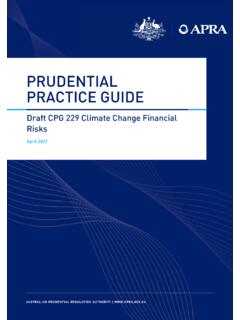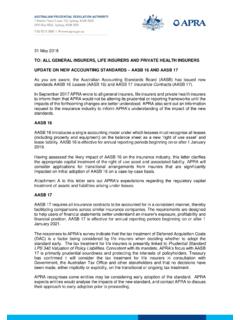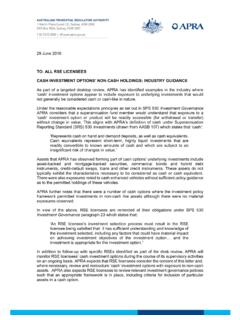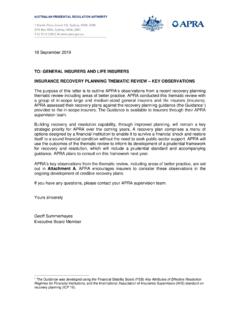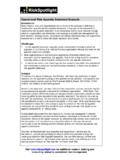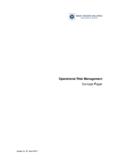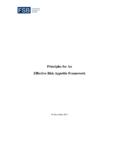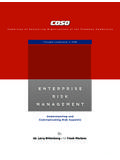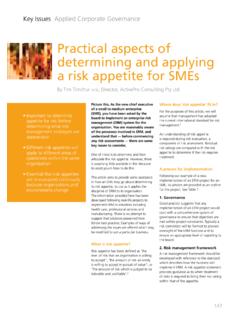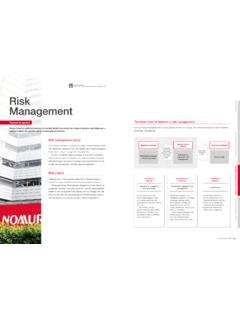Transcription of APG 223 Residential Mortgage Lending - apra.gov.au
1 APG 223 Residential Mortgage Lending February 2017 AUSTRALIAN PRUDENTIAL REGULATION AUTHORITY 2 Disclaimer and Copyright This prudential practice guide is not legal advice and users are encouraged to obtain professional advice about the application of any legislation or prudential standard relevant to their particular circumstances and to exercise their own skill and care in relation to any material contained in this guide. APRA disclaims any liability for any loss or damage arising out of any use of this prudential practice guide. Australian Prudential Regulation Authority (APRA) This work is licensed under the Creative Commons Attribution Australia Licence (CCBY ). This licence allows you to copy, distribute and adapt this work, provided you attribute the work and do not suggest that APRA endorses you or your work. To view a full copy of the terms of this licence, visit AUSTRALIAN PRUDENTIAL REGULATION AUTHORITY 3 Contents About this guide 4 Background 5 Risk management framework 5 Loan origination 10 Specific loan types 17 Security valuation 20 Hardship loans and collections 24 Stress testing 26 Lenders Mortgage insurance 27 Glossary 28 AUSTRALIAN PRUDENTIAL REGULATION AUTHORITY 4 About this guide Prudential practice guides (PPGs) provide guidance on APRA s view of sound practice in particular areas.
2 PPGs frequently discuss legal requirements from legislation, regulations or APRA s prudential standards, but do not themselves create enforceable requirements. This PPG aims to outline prudent practices in the management of risks arising from Lending secured by mortgages over Residential properties, including owner-occupied and investment properties. It applies to authorised deposit-taking institutions (ADIs) as well as to other APRA-regulated institutions that may have exposures to Residential mortgages. It should be read in conjunction with prudential standards for ADIs, including: Prudential Standard APS 220 Credit Quality (APS 220); Prudential Standard CPS 220 Risk Management (CPS 220); Prudential Practice Guide CPG 220 Risk Management (CPG 220); and Prudential Standard CPS 510 Governance (CPS 510). Subject to meeting APRA s prudential requirements, and legislative and regulatory requirements governing consumer Lending by ADIs and third parties acting on their behalf, an APRA-regulated institution has the flexibility to manage Residential Mortgage Lending in a manner that is best suited to achieving its business objectives.
3 Not all of the practices outlined in this PPG will be relevant for every institution and some aspects may vary depending upon the size, complexity and risk profile of the institution. AUSTRALIAN PRUDENTIAL REGULATION AUTHORITY 5 Background 1. Lending secured by mortgages over Residential property ( Residential Mortgage Lending ) constitutes the largest credit exposure in the Australian banking system, and for many authorised deposit-taking institutions (ADIs) constitutes over half their total credit exposures. This concentration of exposure warrants ADIs paying particular attention to Residential Mortgage Lending practices. 2. This prudential practice guide (PPG) summarises prudent Lending practices in Residential Mortgage Lending in Australia, including the need to address credit risk within the ADI s risk management framework, sound loan origination criteria, appropriate security valuation practices, the management of hardship loans and a robust stress-testing framework.
4 In developing this PPG, APRA has had regard to the Financial Stability Board s (FSB) Principles for Sound Residential Mortgage Underwriting Practices1 (FSB principles), which sets out minimum underwriting (loan origination) standards that the FSB encourages supervisors to implement. Although the exact details may differ somewhat to reflect local conditions, APRA would expect a prudent ADI undertaking Residential Mortgage Lending outside of Australia to apply Lending standards and risk management practices that are similarly conservative to those outlined in this PPG. Risk management framework APRA s expectations of an ADI Board for Residential Mortgage Lending 3. Where Residential Mortgage Lending forms a material proportion of an ADI s Lending portfolio and therefore a risk that may have a material impact on the ADI, APRA expects that the Board would take reasonable steps to satisfy itself as to the level of risk in the ADI s Residential Mortgage Lending portfolio and the effectiveness of its risk management framework.
5 This would, at the very least, include: a) specifically addressing Residential Mortgage Lending in the ADI s risk appetite , risk management strategy and business plans; 1 Consistent with Prudential Standard CPS 220 Risk Management (CPS 220), where Residential Mortgage Lending forms a material proportion of an ADI s Lending portfolio and therefore represents a risk that may have a material impact on the ADI, it would be prudent for the Board of directors (the Board) and senior management to specifically address Residential Mortgage Lending in its risk management framework, in particular in the risk appetite statement, risk management strategy and business plans. AUSTRALIAN PRUDENTIAL REGULATION AUTHORITY 6 b) seeking assurances from senior management that the approved risk appetite is communicated to relevant persons involved in Residential Mortgage Lending and is appropriately reflected in the ADI s policies and procedures; and c) seeking assurances from senior management that there is a robust management information system in place that: i) tracks material risks against risk appetite ; ii) provides periodic reporting on compliance with policies and procedures, reasons for significant breaches or material deviations and updates on actions being taken to rectify breaches or deviations; and iii) provides accurate, timely and relevant information on the performance and risk profile of the Residential Mortgage Lending portfolio.
6 Risk appetite including Residential Mortgage Lending 4. The overarching risk appetite statement required under CPS 220 would typically include an expression of the level of credit risk an ADI is willing to accept. Such a statement would be expected to adopt a forward-looking view of the ADI s credit risk profile and align with its business plan and risk management strategy. 5. Where Residential Mortgage Lending forms a material proportion of an ADI s Lending portfolio and therefore represents a risk that may have a material impact on the ADI, the accepted level of credit risk would be expected to specifically address the risk in the Residential Mortgage portfolio. Further, in order to assist senior management and Lending staff to operate within the accepted level of credit risk, quantifiable risk limits would be set for various aspects of the Residential Mortgage portfolio. When setting risk limits for the Residential Mortgage portfolio, a prudent ADI would consider the following areas: a) loans with differing risk profiles ( interest-only loans, owner-occupied, investment property, reverse mortgages, home equity lines-of-credit (HELOCs), foreign currency loans and loans with non-standard/alternative documentation); b) loans originated through various channels ( mobile lenders, brokers, branches and online); c) geographic concentrations; d) serviceability criteria ( limits on loan size relative to income, (stressed) Mortgage repayments to income, net income surplus and other debt servicing measures); e) loan-to-valuation ratios (LVRs), including limits on high LVR loans for new originations and for the overall portfolio; f) use of lenders Mortgage insurance (LMI) and associated concentration risks .
7 AUSTRALIAN PRUDENTIAL REGULATION AUTHORITY 7 g) special circumstance loans, such as reliance on guarantors, loans to retired or soon-to be-retired persons, loans to non-residents, loans with non-typical features such as trusts or self-managed superannuation funds (SMSFs); h) frequency and types of overrides to Lending policies, guidelines and loan origination standards; i) maximum expected or tolerable portfolio default, arrears and write-off rates; and j) non- Lending losses such as operational breakdowns or adverse reputational events related to consumer Lending practices. 6. Good practice would be for the risk management framework to clearly specify whether particular risk limits are hard limits, where any breach is escalated for action as soon as practicable, or soft limits, where occasional or temporary breaches are tolerated. 7. In keeping with good practice, an ADI would balance the need to regularly review its risk appetite and risk limits in relation to Residential Mortgage Lending , with the need to avoid too-frequent and disruptive change.
8 APRA would be concerned if risk limits were frequently redefined in a manner that leads to obscured limit breaches or to greater risk-taking outside the ADI s overall risk appetite . This could include, for example, changing between portfolio and origination limit measures, or between including and excluding capitalised LMI premiums in risk limits. Oversight and review 8. Consistent with CPS 220, an ADI would have policies and procedures for identifying, measuring, monitoring and controlling material risks in the Residential Mortgage Lending portfolio. 9. Typically, senior management is responsible for monitoring compliance with material policies, procedures and risk limits and reporting material breaches or overrides to the Board. Further, where risk limits are routinely breached or policies and procedures overridden, senior management and the Board could consider whether this is indicative of a less prudent Lending culture than that reflected in its risk appetite and what steps could be necessary to remedy any identified deficiency.
9 10. In order to establish robust oversight, the Board and senior management would receive regular, concise and meaningful assessment of actual risks relative to the ADI s risk appetite and of the operation and effectiveness of internal controls. The information would be provided in a timely manner to facilitate early corrective action. 11. A prudent ADI would have controls in relation to its Residential Mortgage portfolio that have appropriate regard to the level of risk within the portfolio. Portfolios that have higher inherent risk, for example where the portfolio is usually operating at the higher end of risk limits, would typically be accompanied by stronger controls, including: a) increased senior management oversight; AUSTRALIAN PRUDENTIAL REGULATION AUTHORITY 8 b) increased monitoring and more granular reporting to the Board and senior management; c) increased level and frequency of reviews by the risk management function; d) increased level of internal audit; e) stronger default management and collection capabilities; and f) provisioning and capital levels reflective of the risk of the portfolio.
10 12. Consistent with CPS 220, the aspects of the risk management framework that apply to the Residential Mortgage Lending portfolio would be subject to a comprehensive review by an operationally independent and competent person at least every three years. The person would report the results of reviews to the Board, providing an independent and objective evaluation of the appropriateness, adequacy and effectiveness of the risk management framework with respect to the portfolio. 13. Failure to meet responsible Lending conduct obligations, such as the requirement to make reasonable inquiries about the borrower s requirements and objectives, or failure to document these enquiries, can expose an ADI to potentially significant risks . A prudent ADI would conduct a periodic assessment of compliance with responsible Lending conduct obligations to ensure it does not expose itself to significant financial loss.
